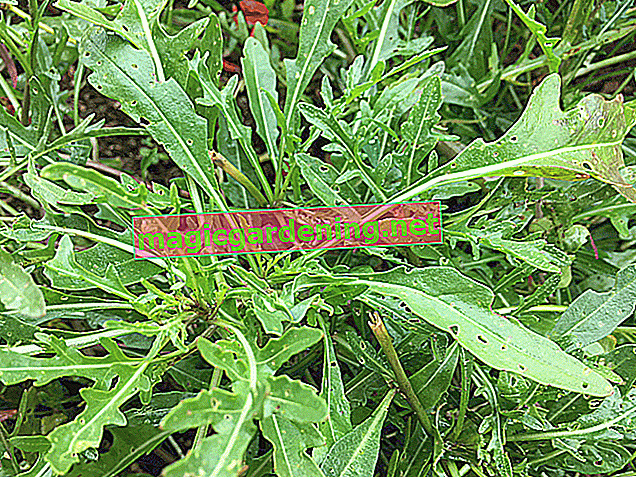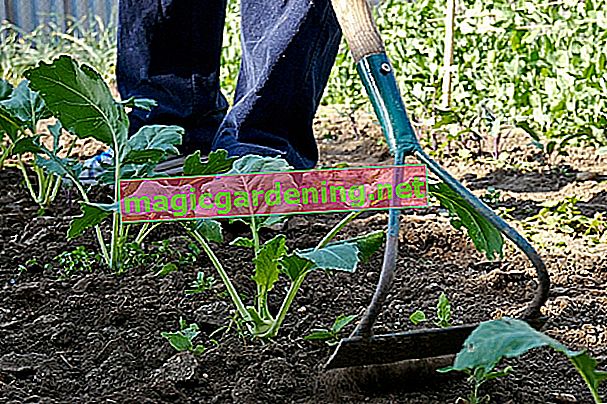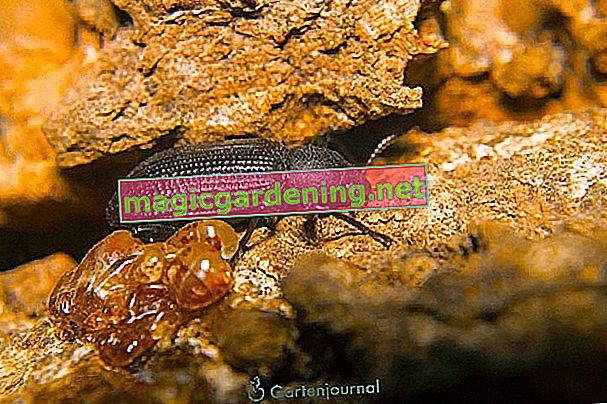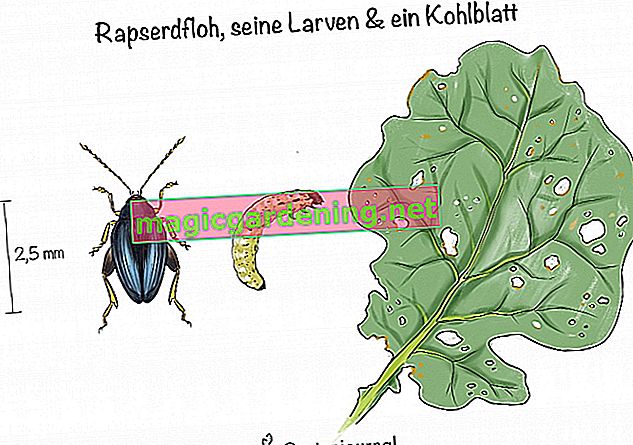
the essentials in brief
- Fleas can be combated with strips of glue or beneficial insects
- Adult fleas are only 4mm tall
- Earth fleas leave countless tiny holes in the infested leaves
- Weeding not only helps against weeds, it also prevents flea infestation
Fight fleas effectively
In spring in particular, you should keep a close eye on your seedlings and young plants and check them regularly for an infestation with fleas - a quick reaction is important at this point in order to save the plants. Later in the year the main task is to prevent the larvae from pupating and the adult beetles from overwintering. For this purpose, it makes sense to regularly loosen the soil in the vegetable patch, remove weeds and keep the soil slightly damp - but by no means wet! - to keep. The measures described below also help.
also read
- Fleas have no place in the flower pot
- Fire bugs in the garden - fight or protect?
- Fight mosquitoes in the garden
In the garden in particular, the principle “a lot helps a lot” does more harm than good.
Glue strips
This simple remedy is quite effective in controlling adult fleas, but must be used over and over again throughout the growing season. Buy a bucket of caterpillar glue at a garden center, coat several wooden boards with it and place them between the vegetable plants at regular intervals. The fleas jump on it in case of disturbances, stick and can finally be collected and disposed of together with the boards.
Natural enemies
The preferred hiding places of earth fleas (genus “Phyllotreta”) such as piles of leaves and wood also attract many animal garden helpers, where the small beetles, their larvae and other pests are on the menu. Bring these beneficial insects into the garden in a targeted manner (some insects can be bought in specialist shops, for example) and create pleasant habitats for the animals such as hiding places or a conveniently placed insect hotel. (€ 8.87 at Amazon *)
These animals target earth fleas:
- Hedgehog
- Shrew
- Ground beetle
- Predatory beetle
- Parasitic wasp
Attractants
Also quite simple and easy to implement is a decoy plant that is planted in the middle of the bed and is supposed to keep the fleas away from the other plants. Use a type of plant that is particularly popular with the animals - for example broccoli or radish - that should be slightly larger than the other bed dwellers. Plant them together with their pot in the bed so that you can later dispose of the eggs and larvae at the same time. In contrast to the other bedding plants, keep the attractant plant dry and do not hoe it. Once the beetles have settled on it, wrap the plant in a plastic bag on a hot and dry day and remove it from the bed. But don't wait too long, otherwise the animals will look for another food plant.
This is how you recognize fleas in time
Due to their small size of only up to four millimeters in length, adult fleas are difficult to recognize. However, the animals leave a characteristic damage pattern on the leaves and also on the stems of the eaten plants, by means of which they can be easily recognized. The leaf surfaces are covered with numerous round, tiny holes. These are usually smaller than four millimeters. The greatest damage occurs when overwintering fleas attack young plants in large numbers between April and May and actually eat them up. The long hind legs of the fleas are characteristic.
View this post on InstagramDear # earth fleas! Please be so kind and use the #Rain. Swimming is very healthy, if you could manage a few hundred meters that would be great. I'll keep my fingers crossed for you ✊ Then we can soon pamper our customers again with #broccoli, #karfiol, #kraut, #kohlrabi and #rucola. We will surely see each other again, until then I wish you a wonderful summer 🤩 Your Meindlhof # erdflohloverskohlgemüse # wirliebkohlgemüseauch # Leidereinigeernteausfalls # dasistdienatur # #hilftnix #meindlhof #hofladen #bauernmarktregau #bauernmarktschwanenstadt
A post shared by Meindlhof - natural vegetables (@meindlhof_natuerlichgemuese) on Jul 7, 2019 at 2:21 am PDT
Tips
A flea infestation should also be combated because the feeding points on the leaves and other parts of plants serve as entry points for certain fungi such as those from the genus Phoma and thus cause additional damage through a fungicidal infection.
Which plant species are most affected?
Due to the widespread distribution of the great rapeseed flea, especially plant species from the cruciferous family (bot. Brassicaceae) are strongly affected in the garden. This plant family includes numerous important vegetable and ornamental plants, as the following table shows:
| Vegetables | Ornamental plants |
|---|---|
| Radishes, rocket, broccoli, kohlrabi, white and red cabbage, cauliflower, radish, Chinese cabbage, pak choi, tomatoes, potatoes, peppers | Levkoje, gold lacquer, night viola, blue pillows |
Not only cruciferous vegetables are affected, other plant species are also affected. For example, fleas are often found on basil or hollyhocks. As a rule, fleas only eat the leaves of the plants, but in rare cases the tubers in the soil can also be affected. For example, the larvae also find the radishes, which are often sown early in the year, very tasty.
Prevention is better than fighting
Effectively preventing an infestation with fleas is actually not that difficult - but it does involve some effort. At best, you deprive the animals of their livelihood and ensure that the conditions that are favorable for them to occur are not even given. You have to know that the leaf beetles appear especially in warm and dry weather - and also attach great importance to rest.
Infestation can be significantly reduced or even completely prevented if you only regularly hoe through the vegetable patch, pull weeds and disturb the animals by doing this. You are quickly looking for a quieter environment. Furthermore, you should keep the soil moist by watering and / or spraying regularly - of course only as far as it is conducive to plant growth, after all, waterlogging is also harmful - and cover the root area with a layer of mulch. This keeps the moisture in the soil, so that the larvae on the roots are also hindered in their development.

The right time
The measures mentioned are to be carried out from the end of March / beginning of April and then regularly during the summer months. In spring you disturb the wintering adult beetles, between June and August you prevent the larvae from pupating. However, be careful not to destroy the roots of the plants.
Mixed culture in the vegetable patch
In a mixed culture, the gardener plants different types of plants together in a bed instead of populating it with a single variety. The advantage of such a mixing is that the different plants strengthen and complement each other - and the whole harvest is not at risk, as is the case with a monoculture. Just as cabbage plants attract the cabbage fleas, they are also deterred by certain plants - above all onions and garlic. You should therefore plant both vegetables close to the cruciferous vegetables - but be careful, cabbage vegetables and onions or garlic are not necessarily ideal plant partners, as they in turn hinder each other in other ways.
Regular watering with vegetable manure
Instead of cultivating a mixed culture of cabbage and onions, you can also water the plants with manure that you have prepared yourself. This is a tried and tested organic home remedy that is easy to manufacture and, unlike chemical sprays, does not show any undesirable side effects. This method not only drives away fleas (and other pests and pathogens), but also supplies the vegetable plants with fresh, easily accessible nutrients. In addition to onions and garlic, the tansy tansy (also known as wormweed), which can often be found on roadsides, and wormwood (bitter mugwort) are also suitable for this purpose. You can find all the ingredients either in your own garden or in the great outdoors.
How to make a plant manure yourself
The production of effective plant manure takes one thing above all: a lot of time. The mixture has to ferment for at least ten to 14 days, which is why you should let it move to a warm, but dark - and especially remote place in the garden because of the smell. Do not fill the mixture into a metal container, but rather into a plastic or enamel bucket. Use a wooden stick to stir.
Step-by-step instructions for effective plant manure
- Freshly harvest one kilogram of suitable plant material
- Chop it up carefully and pour it into a bucket
- Pour ten liters of fresh water over it
- Add a handful of rock flour (€ 14.95 at Amazon *) to create a smell
- Cover the container with a jute net only
- stir daily
The liquid manure is ready when the liquid stops foaming when it is stirred. Now dilute it 1:10 with water and water your plants with it.
Digression
Mulch as a lower-odor alternative to liquid manure
Unfortunately, the production as well as the use of vegetable manure is a very odor-intensive matter. Alternatively, you can use onion peels, finely chopped garlic, and shredded tansy to mulch vulnerable vegetable patches. The following video shows this very well using the example of nettle mulch. YoutubeWhat are earth fleas?
Contrary to what their name suggests, earth fleas are not fleas. In fact, there are various types of leaf beetles (Latin Chrysomelidae) behind the misleading name. However, the tiny animals, which are only between one and a half to three millimeters in size, have one thing in common with their namesakes: thanks to their powerful jumping legs, the adult beetles hop away from disturbances like fleas.
Both the adult animals and their larvae live phytophagus, as the biologist calls herbivores. In doing so, the insects feast on the leaves of various plant species as well as on their roots and therefore cause great damage both in commercial agriculture and in domestic vegetable gardens. While the larvae live underground, the adult beetles are on the surface after their pupation and reproduce very diligently. This creates several generations per year that annoy the gardener considerably throughout the entire growing season.

Different types
However, not all earth fleas are alike, because they are a genus comprising around 200 different species. Psylliodes, as the earth fleas are scientifically called, are represented in Europe with around 100 species and their subspecies. These have mostly specialized in certain plant genera and species and can only be found on these. Since it is not a single species, the leaf beetles have a very different appearance. They can be blue-black or bronze-colored, blue, gray, yellow or even striped - the variety of oval, elongated beetles is extremely large.
These three types are particularly difficult for garden owners:
| Earth flea species | Latin name | Appearance | Preferred plant species |
|---|---|---|---|
| Potato flea | Psylliodes affinis | dark brown shell, yellow vertical stripes | Potatoes, tomatoes and other nightshades |
| Large rapeseed flea | Psylliodes chrysocephalus | shiny, blue-black to dark green shell | Rocket, radish, radishes, various types of cabbage and other cruciferous vegetables |
| Hop earth flea | Psylliodes attenuatus | bronze-colored to metallic green shining armor, yellow-red legs and antennae | Hops, hemp and nettles |
The big rapeseed flea appears most frequently, and it likes to make itself comfortable in the vegetable patch and find all kinds of delicious dishes there.

Way of life and reproduction
Fleas become active with the warm spring temperatures, as the female animals lay their eggs mainly in small holes in the ground on the roots of the preferred plant species, but also on their leaves. The white larvae hatch about ten days after laying their eggs and feed underground on the delicate thread roots of the plants. The damage caused here initially remains invisible, but is not yet too serious either. After about three weeks, the larvae pupate in an earth cocoon and finally hatch between June and August. Only the adult beetles cause considerable damage through their feeding activity, which manifests itself as follows:
- Leaf tissue : is scraped off with the mouthparts
- Leaf surface : mainly young plants are destroyed
- Window corrosion : the damaged tissue dries off, turns brown and tears
The older, well-grown and therefore more robust plants are less at risk than the young plants. Seedlings and seedlings in particular do not yet have enough resistance to assert themselves against flea infestation and die quickly.
While an infestation in kohlrabi or broccoli does not seem too dramatic - after all, plant parts other than the leaves are consumed here - clearly visible traces of flea in leafy vegetables such as rocket or savoy cabbage are not very appetizing.
Adult fleas overwinter in the garden
The adult fleas overwinter in the garden and find shelter mainly in the ground, but also in layers of mulch and leaves, under plant residues (also on the compost!), In piles of stones and wood as well as in hedges. From here they start their extermination campaign early in the year when the temperatures are right and should therefore be fought sustainably in any case.
Digression
Earth fleas in a flower pot
The annoying leaf beetles can not only appear in the garden, but also in the greenhouse and even with house plants. Fleas in the house are a particularly troublesome affair, after all they cannot be fought here with the usual means such as hoes and plant manure. Instead, there is an old home remedy that works reliably: Insert a few matches into the flower pot with the sulfur head side down and keep the substrate slightly moist. The leaf beetles do not tolerate the sulphurous material and disappear.frequently asked Questions
How can I still protect my young plants from pests?
Healthy, vigorous plants are usually very capable of defending themselves against pests and pathogens. Strengthen your crops with an adequate supply of nutrients. In particular, the regular spreading of compost (starting early in the year) has proven to be useful and strengthen the plants. You should also cover young plants in spring with a close-meshed insect protection net (mesh size 0.8 mm) or garden fleece.
Is it true that fleas also avoid spinach and lettuce?
Experience has shown that fleas also like to go to lettuce plants, which is why these are not particularly suitable as an avoidance strategy. The animals, on the other hand, don't really like spinach. Try to mulch with shredded spinach leaves - but be careful: snails also like to eat the leafy vegetables. Therefore, a snail fence or another defense strategy makes sense to keep the voracious animals away.
Can't I fight fleas with insecticides too?
In principle, of course, it is also possible to put an end to the annoying earth fleas with insecticides from specialist retailers. There are some suitable preparations for this, but they all have a serious disadvantage: They not only poison earth fleas, but also other insects and also ensure that your vegetables are also contaminated. Biologically based pesticides, such as the pesticides already mentioned or neem oil, are better.
Is it true that rye flour helps against fleas?
In fact, rye flour is an old household remedy for fleas and drives them away. To do this, dust the plant completely with the flour, which can also be used with algae lime. However, both are only effective against the adult animals and not against their larvae, and powdering can prevent the plant from photosynthesis and thus impair growth and development.
Tips
Always wear gardening gloves and long clothing when working in the vegetable patch, as fleas like to bite. The bites cause an itchy rash and can be dangerous to allergic people.








